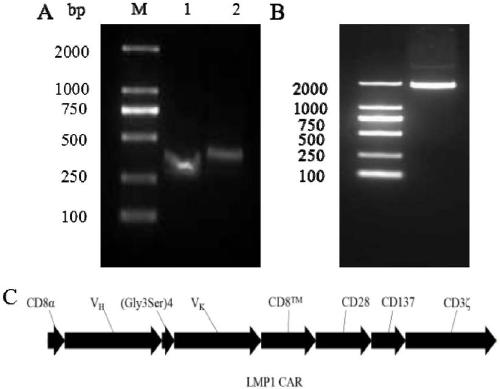Preparation method and application of third-generation LMP1 (latent membrane protein 1) CAR-T (Chimeric Antigen Receptor T) cells
A cell and extracellular region technology, applied in the field of genetic engineering and immune targeted therapy, can solve problems such as the lack of third-generation LMP1CAR-T cells
- Summary
- Abstract
- Description
- Claims
- Application Information
AI Technical Summary
Problems solved by technology
Method used
Image
Examples
Embodiment 1
[0099] Example 1 Construction of lentiviral expression vector for anti-LMP1 CAR
[0100] 1.1 Design and synthesis of LMP1 scFv primers targeting LMP1 chimeric antigen receptor LMP1 CAR extracellular region
[0101] The fully human anti-LMP1 antibody Fab constructed in the laboratory was analyzed with the biological software DNAstar 8.0, and the variable region of the light chain (Vκ) and the variable region of the heavy chain (Vκ) were designed and amplified. H ) primers were optimized, and the primers were finally synthesized by Beijing Qingke Xinye Biotechnology Co., Ltd.
[0102] LMP1scFv heavy and light chain variable region primer sequences are as follows:
[0103]
[0104] The direction of the above primers are all 5'-3'
[0105] 1.2 Synthesis and amplification of heavy and light chain variable regions of LMP1 scFv segment targeting LMP1 chimeric antigen receptor LMP1 CAR extracellular region
[0106] 1) Reaction system (take 50ul system as an example):
[0107] ...
Embodiment 2
[0191] Example 2 LMP1 CAR virus packaging
[0192] 1) Collect X-293T cells, inoculate them on a 10cm culture dish and continue culturing. When the cell confluence reaches 70%, replace with fresh incomplete medium 30 minutes before virus packaging; 2) 1.5ml centrifuge tube A: 470ul Opti-MEM+30ul PEI , resuspend and incubate at room temperature for 5min; 1.5ml centrifuge tube B: 3.3ug psPAX2+3.3ug pMD2.G+3.3ug LMP1 CAR, add Opti-MEM to 250ul; 3) Add the reagents in tube A to tube B dropwise , mix gently, and place at room temperature for 15 minutes; 4) Add the mixture dropwise to X-293T cells, shake the culture dish gently to make the mixture evenly distributed, and incubate in a 37°C incubator; 5) After 6-8 hours, replace with fresh Complete medium (1640+10% FBS); 6) Observe the transfection efficiency under a fluorescent microscope after 24 hours; 7) Collect the supernatant after 48 hours, if the cells adhere well, replace with fresh incomplete medium (1640+10% FBS) The cultu...
Embodiment 3
[0193] Example 3 Concentration of LMP1 CAR virus
[0194] method one:
[0195] 1) After the supernatant collected in Example 2 is filtered through a 0.45um filter membrane, it is transferred to a 100kD ultrafiltration tube and concentrated to 1 / 3 volume;
[0196] 2) The concentrated solution was filtered through a 0.22um filter membrane, and the filtrate was collected and frozen at -80°C.
[0197] Method Two:
[0198] 1) Dissolve 8.76g NaCl and 50g PEG-8000 in 200ml double distilled water respectively, and autoclave to prepare 5×PEG-8000 NaCl solution; 2) The virus supernatant collected in Example 2 was mixed with 5 Mix ×PEG-8000NaCl, shake once every 20-30min, 5 times in total, overnight at 4°C; 3) Centrifuge at 6000rpm for 20min, remove the supernatant; 4) Collect the precipitate, resuspend in medium, and freeze at -80°C.
PUM
 Login to View More
Login to View More Abstract
Description
Claims
Application Information
 Login to View More
Login to View More - R&D
- Intellectual Property
- Life Sciences
- Materials
- Tech Scout
- Unparalleled Data Quality
- Higher Quality Content
- 60% Fewer Hallucinations
Browse by: Latest US Patents, China's latest patents, Technical Efficacy Thesaurus, Application Domain, Technology Topic, Popular Technical Reports.
© 2025 PatSnap. All rights reserved.Legal|Privacy policy|Modern Slavery Act Transparency Statement|Sitemap|About US| Contact US: help@patsnap.com



